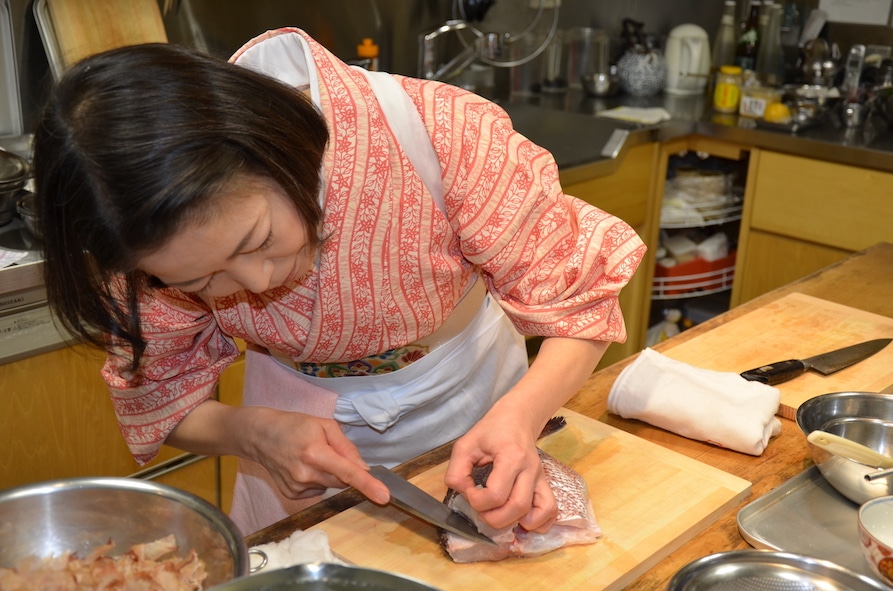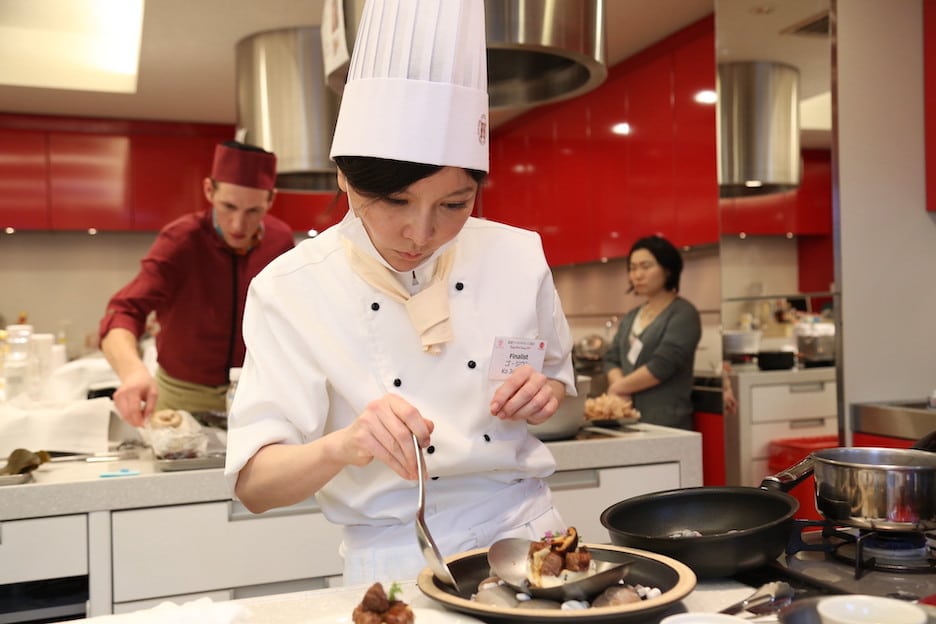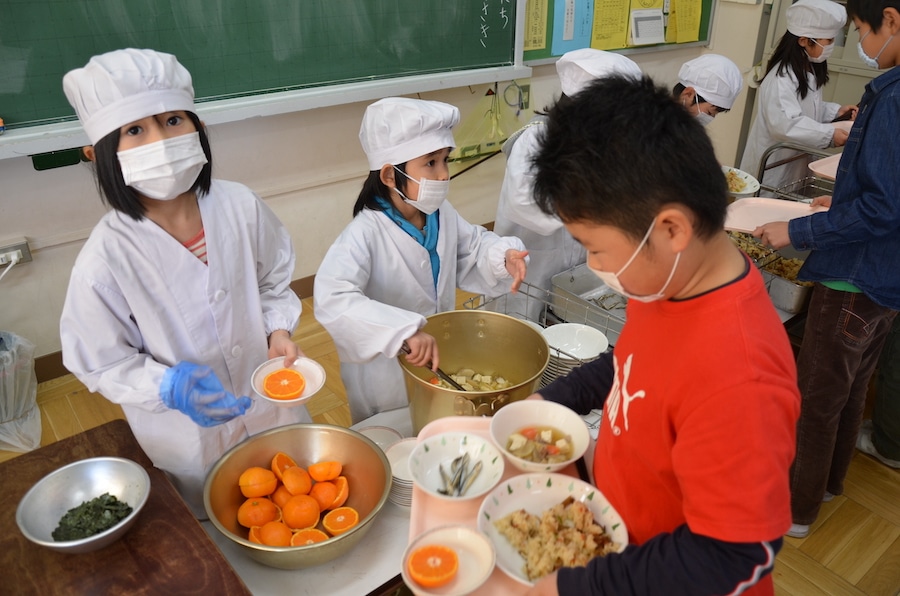
Chef Takako Fujita demonstrates how to prepare a traditional ‘one soup, three dishes’ Japanese lunch
By David DeVoss
The Japanese, stuck in a deadly epidemic of Covid-19, confronted by an unpopular Olympics end experiencing waning geopolitical influence, are pushing past these frustrations with a new government-led campaign to sell the world—and their own children—on their country’s distinctive traditional cuisine.
Unfortunately, they’re not talking about shrimp tempura, California rolls, or spicy tuna sashimi. This “commercial” Japanese food has long since won over Europe and the Americas, just as Western food has made inroads in Japan. No, the traditional washoku cooking that is becoming Japan’s new new thing consists of umami-flavored fish, soya, mushrooms, and seaweed steeped in dashi, a liquid made by boiling desiccated kelp with dried tuna shavings. It is, for some, an acquired taste.
Yet the campaign’s sponsors have high hopes. “We want Japan’s real dietary culture to become a pop culture for the world,” says Hiroko Kaizuka, a senior deputy director with the Ministry of Foreign Affairs. “Once people learn to appreciate washoku they will love Japan and its people.”
If this sounds far-fetched, consider that French celebrity chef Alain Ducasse is an enthusiastic supporter of Tokyo’s effort to climb to the top of the international food pyramid, as is Jean-Robert Pitte, president of the French Mission for Food Heritage and Cultures. “Since the days of Napoleon, France has used its cuisine as an imperialistic element to seduce the rest of Europe,” he explains. “It’s harder for an island nation to communicate the complexities of fish and rice.”
Japan’s gastronomic campaign was launched in December 2013 when Tokyo convinced UNESCO to list washoku as part of the Intangible Cultural Heritage of Humanity. Two years later, Japan underscored its commitment by staging the Washoku World Challenge, an international competition that brought 10 foreign chefs to Kyoto to see who best could master the subtleties of savory umami cuisine. Seattle sushi chef Aaron Pate, whose soya milk shabu-shabu was edged out in the final round by a competitor from Thailand, represented the United States. Today, Washouku cook offs occur around the world each year.

Gifted chefs of Japanese cuisine gather annually in different world capitals to compete in the preparation of traditional washoku dishes.
For Kyoto mayor Daisaku Kado-kawa the events demonstrate “the superiority of a society that feeds tofu to people, not soybeans to cattle.” Other political observers see the competitions as an attempt to rescue traditional Japanese food from irrelevance.
Part of the impetus for the campaign is the belief that Japan is losing its soul to globalization. Certainly fewer Japanese adults are eating traditional food. Over the past decade even the consumption of sake has declined 40 percent as people switch to wine and beer.
The move away from the Japanese paleo diet of dried kelp, anchovies, fermented sauces, and herring roe began as long ago as 1872, when the Meiji emperor finally allowed the people of Japan to eat meat. Back then meat was seen as the most modern of proteins.
Today, the rejection of traditional food is especially pronounced among the young. Yoshihiro Murata, chairman of Japan’s Culinary Academy, first sensed an impending crisis several years ago when he observed that schoolchildren were unable to distinguish Japanese dishes from Western ones. “Their favorite foods were curry rice and spaghetti,” he recalls with disgust. Nutritionist Yukio Hattori, host of the Iron Chef television program that ran for six years in 89 countries, says the problem has only grown with time. “It’s hard to go back once you get used to Western food,” he sighs. “Today we’re seeing that many kids don’t even know how to use chopsticks.”
Countering that cultural loss is an ambitious public school lunch program in which every elementary student receives a 500-calorie lunch, freshly prepared in each school and served by the students who will eat it. “The principal is the first person to eat lunch,” says Masahiro Oji, director of the Ministry of Education’s School Health Education Division. “If he gets sick none of the rest of the food gets served.”

Lunch at Sanya Elementary School in Tokyo is an occasion for food education
At the Sanya Elementary School in Tokyo’s Suginami ward, students visit local farmers, maintain their own vegetable garden, and receive full accounting before every lunch on the provenance of each dish they are served.
Its promoters say washoku should be embraced not only for the sake of tradition but also for its health benefits. To be sure, Japan’s present Western-influenced diet has produced one of the healthiest societies in the world. Only 3.5 percent of Japanese are considered obese—one-tenth of the U.S. figure. And according to the Ministry of Health and Welfare, while 153 Japanese were over the age of 100 in 1964, there are 54,397 centenarians today, and the figure projected for 2025 is over 150,000.
Still, to ensure Japanese children develop a taste for low-calorie food, University of Kyoto chemists and the Meiji food company have developed a new “fishier” baby food that partially replaces meat, potatoes, and green beans with kelp, tofu, miso, and tuna. “Babies prefer food with more fat and sugar,” admits Meiji nutritionist Eiji Kanno, “but if they don’t learn to like the dashi taste as a toddler they’ll never enjoy the Japanese taste as an adult.”
Kyoto University professor and Meiji consultant Tohru Fushiki says the baby food smells like “weeds straight from the ocean,” but insists that’s a good thing. “Children growing up with that smell will still eat junk food as teenagers, but they should return to fish as adults.” If so, they’ll be beneficiaries of Tokyo’s massive Tsukiji Fish Market, a marvel of efficiency, which processes one out of every five fish caught in the world. They’ll also be prime candidates to embrace the washoku revival.![]()
David DeVoss, editor of the East-West News Service and recipient of a 10-day food fellowship from Japan’s Foreign Press Center, is still trying to acquire a taste for washoku.

